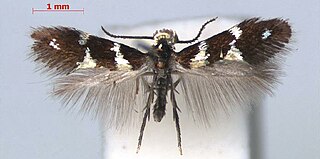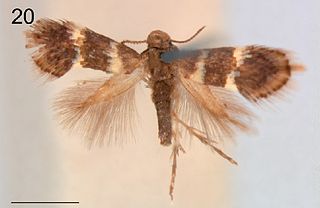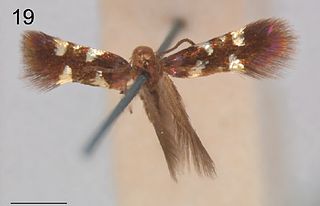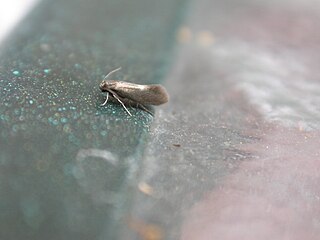
Cyllopsis gemma, the gemmed satyr, is a species of butterfly of the family Nymphalidae. It is found in the southeastern United States and northeastern Mexico.

Antispila oinophylla is a species of moth of the family Heliozelidae. It is found in North America, including Ontario, Quebec, Connecticut, Georgia, Kentucky, New York, Tennessee and Vermont. Records under Antispila ampelopsifoliella from Maine, Missouri and Ohio may also partly refer to this species. In Europe, it is introduced into northern Italy.

Antispila ampelopsifoliella is a species of moth of the family Heliozelidae. It is found in eastern North America, including Connecticut, Kentucky, New York, Vermont and Ontario.

Antispila voraginella is a species of moth of the family Heliozelidae. It is found in the Rocky Mountains, including Utah, Arizona and western Texas.

Antispila hydrangaeella is a species of moth of the family Heliozelidae. It is widespread in the eastern United States, including Georgia, Illinois, Kentucky and North Carolina. However, research suggests that two species might be involved under this name.

Antispila isabella is a species of moth of the family Heliozelidae. It is found in Ontario, Connecticut, Georgia, Kentucky, New York, Pennsylvania and Vermont. However, research concludes that a complex of species is involved under this name.
Antispila is a moth of the family Heliozelidae. It was described by Hubner in 1825.

Heliozela anna, the jamun leaf miner, is a moth of the family Heliozelidae. It was described by Thomas Bainbrigge Fletcher in 1920. It is found in India, including Bengal.
Antispila argentifera is a moth of the family Heliozelidae. It was described by Annette Frances Braun in 1927. It is found in North America, including Ontario.

Antispila argostoma is a moth of the family Heliozelidae. It was described by Edward Meyrick in 1916. It is found in India.

Antispila aristarcha is a moth of the family Heliozelidae. It was described by Edward Meyrick in 1916. It is found in India.
Antispila aurirubra is a moth of the family Heliozelidae. It was described by Annette Frances Braun in 1915. It is found in the US state of California.
Antispila inouei is a moth of the family Heliozelidae. It was described by Kuroko in 1987. It is found in Japan.
Antispila isorrhythma is a moth of the family Heliozelidae. It was described by Edward Meyrick in 1926. It is found in India.
Stephensia major is a moth of the family Elachistidae. It was described by Kearfott in 1907. It is found in North America.
Antispila merinaella is a moth of the family Heliozelidae. It was described by Paulian and Viette in 1955. It is found on Madagascar.
Antispila pentalitha is a moth of the family Heliozelidae. It was described by Edward Meyrick in 1916. It is found in Guyana.
Antispila tateshinensis is a moth of the family Heliozelidae. It was described by Kuroko in 1987. It is found in Japan.
Antispila uenoi is a moth of the family Heliozelidae. It was described by Kuroko in 1987. It is found in Japan. In 2018, the species was found from China.
Agathymus baueri, or Bauer's giant-skipper, is a species of giant skipper in the family Hesperiidae. It is found in North America.







